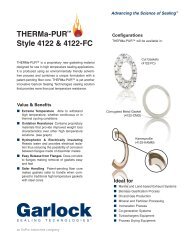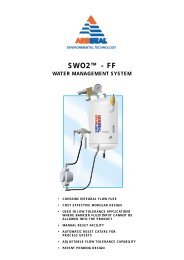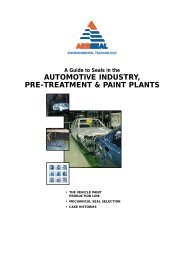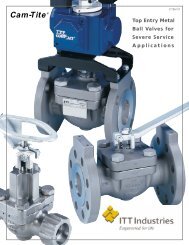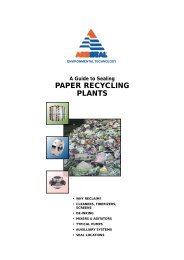expansion joints - AR Thomson Group
expansion joints - AR Thomson Group
expansion joints - AR Thomson Group
You also want an ePaper? Increase the reach of your titles
YUMPU automatically turns print PDFs into web optimized ePapers that Google loves.
MAINTENANCE PROCEDURES<br />
Visual and Physical Inspection of<br />
Expansion Joints<br />
Maintenance programs for elastomeric <strong>expansion</strong><br />
<strong>joints</strong> should consist of visual as well as physical inspections.<br />
These inspections will yield information pertaining<br />
to the condition of the <strong>expansion</strong> <strong>joints</strong>. Rubber <strong>expansion</strong><br />
<strong>joints</strong> will exhibit definite symptoms of premature<br />
failure which could be caused by unnatural stress placed<br />
on the <strong>expansion</strong> joint, typically the result of pipe misalignment.<br />
External inspections will assist in determining<br />
the mode of failure. Internal inspections also contribute to<br />
evaluations, when possible, during outages or when the<br />
<strong>expansion</strong> joint is removed for equipment repairs.<br />
Inspection Criteria<br />
1. Inspection of the tube (internal) - The tube portion<br />
is the most critical part of the <strong>expansion</strong> joint, as this<br />
material comes in direct contact with the media. Any<br />
<strong>expansion</strong> joint which has a damaged tube must be<br />
replaced.<br />
14<br />
a. The joint as a whole may feel soft and spongy.<br />
Typically there is a break in the tube area and the<br />
media has saturated the fabric.<br />
b. Visual examination of the tube may also show thin<br />
areas or even exposed fabric, where the rubber<br />
has been worn away by the flow. This is indicative<br />
of an abrasion problem.<br />
c. Cracking or hardened rubber on the inside usually<br />
indicates excessive temperature. Check temperature<br />
rating of material.<br />
2. External Inspections<br />
a. Leaking at the flange - Upon initial installation,<br />
rubber will set and bolts may need retightening. If<br />
leakage persists, double check the mating flange<br />
for gouges or voids which may affect a seal. Note:<br />
be sure to mate rubber <strong>expansion</strong> <strong>joints</strong> with full<br />
face flat flanges.<br />
b. Cracking on the outside cover - The cover portion<br />
of the joint is rubber and can be changed if<br />
needed to provide compatibility with the environment.<br />
Surface cracking on the outside of the joint<br />
could be the result of environmental attack or<br />
old age.<br />
c. Cracking at the base of the flange - The most<br />
frequent causes of failure are over-elongation<br />
and lateral misalignment. Both are indicated by<br />
cracking at the base of the flange, which is the<br />
most critical stress point. Look carefully to determine<br />
severity. The fabric of the joint will be ex-<br />
posed and broken in the most severe cases.<br />
This is an extremely critical situation and the<br />
joint should be replaced immediately. Measure<br />
the face-to-face and lateral misalignment, order<br />
the proper size (face-to-face) and build-in offset.<br />
d. Delamination - Ply separation is a typical<br />
reaction of materials subjected to unnatural or<br />
excessive movement. This condition is evident<br />
by soft spots. Torsional misalignment and/or<br />
movement are usually the causes for this condition.<br />
Expansion <strong>joints</strong> which show signs of<br />
delamination should be watched carefully and<br />
replaced as soon as possible.<br />
e. Broken body rings - When an <strong>expansion</strong> joint<br />
has been subjected to pressure surges beyond<br />
its capabilities, the metal body rings inside<br />
may break. A slight bulge can be felt between<br />
the arch and the flange area, where the rings are<br />
located. The <strong>expansion</strong> joint should be replaced,<br />
since the structural integrity and dimensional stability<br />
of the <strong>joints</strong> is suspect under these circumstances,<br />
and some <strong>expansion</strong> <strong>joints</strong> do not contain<br />
metal body rings. These <strong>joints</strong> will tend to<br />
balloon under excessive pressure situations and<br />
should be replaced.<br />
Troubleshooting Control Units<br />
The control unit assembly is an added safety<br />
feature which is used to prevent over-elongation and<br />
overcompression of the <strong>expansion</strong> joint (see description<br />
of control units, pages 6 thru 7). If over-elongation<br />
has occurred the rubber washers will be extruded. In<br />
extreme cases, the plates will be bent at an angle.<br />
Consult the manufacturer for assistance. Environmental<br />
attack may cause corrosion on the metal surface of the<br />
control unit. Be sure to order materials compatible with<br />
the atmosphere.



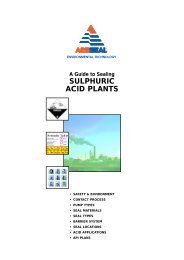
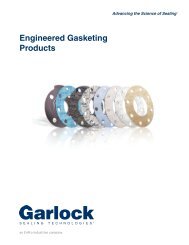
![VCS Flange Gasket [1.03 MB] - AR Thomson Group](https://img.yumpu.com/12044617/1/190x245/vcs-flange-gasket-103-mb-ar-thomson-group.jpg?quality=85)

![PGE Flange Gasket Product Brochure [1.04 MB] - AR Thomson Group](https://img.yumpu.com/12044595/1/190x245/pge-flange-gasket-product-brochure-104-mb-ar-thomson-group.jpg?quality=85)
